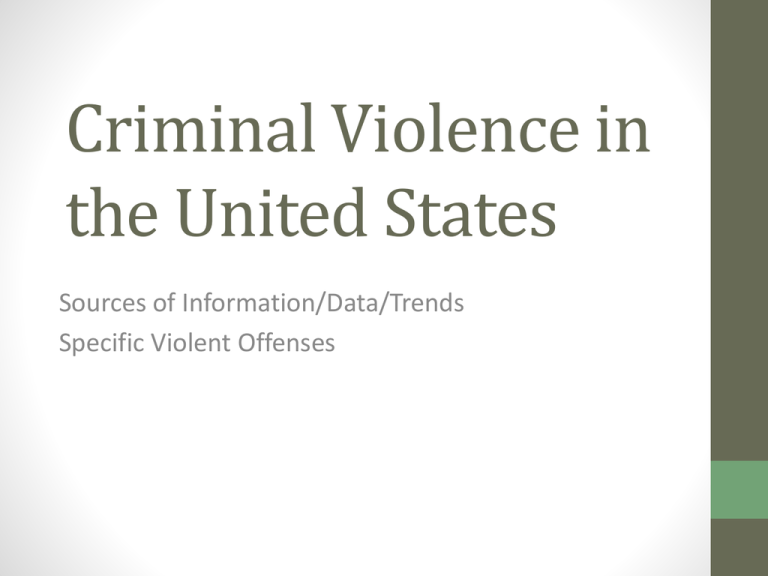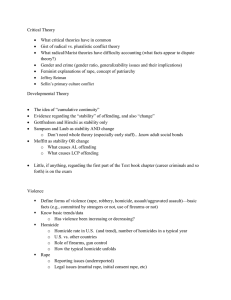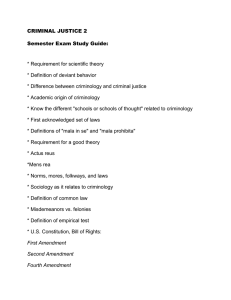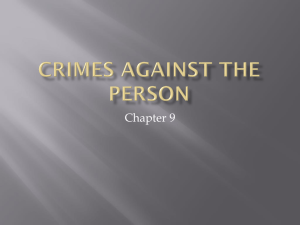
Criminal Violence in
the United States
Sources of Information/Data/Trends
Specific Violent Offenses
Questions about Violence
• How much violence is there in the United States?
• Is violence increasing, decreasing or stable?
• How do we compare to other nations?
• Specific forms of violence
• Homicide
• Robbery
• Rape
• Assault
Sources of Information on Criminal
Violence
• Uniform Crime Reports (UCR) data
• Homicide, Robbery, Aggravated Assault
• National Crime Victimization Study (NCVS)
• Assaults, Robbery, Sexual Assault
• Other data
• Self-reported crime (less serious forms)
• School safety report
NCVS Trends for Violence
Source: Bureau of Justice Statistics: http://bjs.gov
Source: Homicide Trends in the United States, 1980-2008
(U.S. Department of Justice, 2011).
Current UCR Data
• Crimes “known to the police”
• Expressed in rates per 100,000 citizens
2011 Data for U.S. and Minnesota
(http://www.fbi.gov/about-us/cjis/ucr)
Homicide
Rape
Robbery
14,612
4.7 83,425
27
74
1.4 1,664
31
354,396 113
3,386
63.4
Aggravated
Assault
751,131
241
6,701
125
The Crime/Violence Decline
• How do we explain the crime decline?
• What were your thoughts about cases of
homicide?
• Can they explain why homicide and
other serious violence decreased?
• Why do 68-70% of Americans think
crime is getting worse?
• Gallop Poll, 2006-2011
Homicide
▪
▪
▪
▪
▪
▪
▪
Definition: the taking of life by another
human
Classification
Justifiable homicide
First-degree murder
Second-degree murder
Voluntary manslaughter
Involuntary manslaughter
Homicides in Context
• Demographics
• Roughly 90% of homicides perpetrated by males, and
80% of victims are male
• Almost all homicides (90%) are within race, and most
(about 70%) are classified nonstranger
• African Americans disproportionally likely to be victims
and perpetrators
• Circumstances
• The most common circumstance for homicide is an argument
• 68% of homicides caused by firearms (largely handguns)
• Neighborhood level differences
• The ecology of violence, social disorganization
“Its about homicide dummy!”
• The United States has a higher homicide rate
than other industrialized countries
• The difference in firearms death is apparent (5 to 10
higher)
• Also more 2-3 times more likely to murder without
firearms
• Victimization surveys from other countries indicate that
we are similar to other countries in our level of nonlethal
violence
• Canada, Great Brittan, Australia
• An aside: property crime is lower in the U.S. than many
other industrialized countries
Country
United States
Chile
Cuba
Kenya
Canada
Japan
Germany
France
Rwanda
El Salvador
Colombia
Homicides (per 100,000) 2004
5.9
5.5
6
6.7
1.5
0.5
1
1.6
26.6
56.4
61.1
Explaining America’s High
Homicide Rate: Usual Suspects
1. Firearm availability
2. Economic inequality
3. Frontier culture/legacy of violence
Firearm Availability
▪
▪
▪
▪
▪
Strong predictor of homicide rates
U.S. household handgun ownership: 30%
Most other industrialized nations: 1–14%
U.S. non-gun homicide rate: 2.5 times
higher than other industrialized nations
U.S. gun-related homicide: 7.5 times
higher than other industrialized nations
The Gun Control Debate
Federal Gun Control Act
▪
▪
▪
Dealers must be licensed, document sales, refrain from
selling guns to prohibited buyers, etc
Brady Bill: Mandatory 5-day waiting period,
Background checks
Little evidence that they reduce homicide
▪
▪
▪
▪
Secondary guns market is completely unregulated.
Firearms can be purchased illegally.
Firearms may be stolen or borrowed
American History
▪
▪
▪
▪
▪
▪
Sociocultural tradition of violence?
American Revolution
Slavery
Civil War
Treatment of Native Americans
Criticism: other nations with cultural
histories of violence have low homicide
rates today (Japan)
Economic Inequality
Institutional anomie theory, Elliott
Currie’s “market society”
▪ High level of economic inequality
▪ Low level of social support
▪
Criticism = why does this effect homicide
and not other forms of violence? U.S.
similar to Canada and others for assaults
and such.
▪
Columbine, Sandy Hook,
Aurora…
• As “Public Mass Shootings”
• “School Shootings” and school violence
Public Mass Shootings
• Public Mass Shootings in the United States: Selected
Implications for Federal Public Health and Safety Policy
• Congressional Research Service, www.crs.org, March 2013
• What counts?
• Public Places x 4 or more deaths
• How many occur?
• 78 public mass shootings have occurred in the United
States since 1983
• 547 Deaths (1000+ Casualties)
Violence in Schools
• Key Publication
• Indicators of School Crime and Safety: 2011
(2012). Bureau of Justice Statistics, U.S.
Department of Education
• Violent Deaths at Schools
• Other Violence at Schools
Violent Deaths in School
Violent Victimizations
Rape and Sexual Assault
Rape
▪
▪
•
Unlawful sexual intercourse by force
or without legal or factual consent
Debate on “force,” and issues of
“initial consent”
Sexual assault
▪
▪
Defined as: any forced or coerced
sexual intimacy
Rape Information
One of the most underreported crimes
▪
The way rape or sexual assault is
defined impacts estimates
•
Force vs. Coercion, Rape vs. Sexual
Assault
▪
Certain types of rape are reported
disproportionately
•
Stranger vs. Acquaintance
▪
Rape & Sexual Assault Estimates
U.S. rape rate
▪
63 per 100,000 women (UCR)
▪
National Violence Against Women survey
▪
18% of women and 3% of men experienced
(completed or attempted) rape over lifetime
▪
At higher education institutions, as high as
20 to 25% of women over college career
▪
▪
Rape most likely perpetrated by nonstrangers
Date Rape
In the context of dating arrangement
▪
One of the most underreported rapes
▪
Largely unrecognized until the 1980s
Date-rape drugs
▪ Examples: GHB, Rohypnol, and Ketamine
▪ Render the victim physically helpless
▪ Make the victim unable to remember
▪
Marital Rape
▪
▪
▪
▪
Only recently legally recognized
Greatly underreported
Estimates 8–23%
Strong relationship between battering
and marital rape
Explaining Rape and Sexual Assault
▪
Motivation of the offender
▪ Sex?
▪ Violence (sex as a weapon)?
▪ Political/cultural dominance?
Feminist Explanation
▪
Rape = violence, not sex
▪ Maintain control and dominance
▪ Consequence of deep-seated social
tradition
▪
▪
Male dominance & Female exploitation
Cross-cultural studies find a relationship
between gender inequality and rape
Feminist Explanation II
Rape myths influence male behavior
▪ Women secretly desire to be raped,
Women who dress or act seductively are
asking to be raped, When a woman says
“no” to a sexual advance, she actually
means “yes.”
•
Masculine sex role socialization
▪ Aggressive, Forceful, Avoid being
empathetic, Not relationship oriented
▪
Social Learning Perspective
Sexual aggression learned
▪
Behavior shaped by balance of
▪
Role models
▪
Reinforcement/punishment
▪
Attitudes and values
▪
•
•
•
Rape myths, other cognitive distortions as
“negative reinforcement”
Socialization to sex roles
Lack of social skills to express sexuality
normally
Pornography and Rape
Reasons to suspect connection
Reflection of patriarchy
Makes women’s
inequality/submission sexy
Reinforces rape myths
Provides role modeling for sexual
violence
▪
▪
▪
▪
▪
▪
Yet, no clear evidence to support this
theory
Rape and Correctional Intervention
Aversion therapy
▪
Chemical castration
▪
Cognitive-behavioral programs
▪ Eliminate cognitive distortions
▪ Teach cognitive skills
▪
▪
▪
▪
•
Self-control
Problem solving
Anger management
EMPATHY
The Criminal Justice
Response to Rape (1 of 2)
Often difficult for the victim (“Re-victimize”)
Must prove beyond a reasonable doubt that
a crime occurred
▪
▪
▪
▪
▪
Police officers: interrogation
Defense attorneys: must advocate for defendant
Prosecutors: represent the state, must build
solid case, difficult to prove coercion
The Criminal Justice
Response to Rape (2 of 2)
▪
▪
▪
▪
▪
▪
▪
Hospital as key institution for investigation
Medical examination
Collection of physical evidence
Reluctant partner
Proposed solution: rape crisis center
Primary interface between victims and other
agencies
Sole focus on victim support
Robbery
Taking of another person’s property by
force or threat of force
▪
Statistics
▪ Decreasing since the early 1990s
▪ 30% of all serious violent crimes
recorded
▪
Characteristics of Robbery/Robbers
▪
▪
▪
▪
▪
Majority perpetrated by a stranger
May involve multiple offenders
Often interracial crime
Majority young, African-American, male
Common locations of robberies
▪ Street (43%)
▪ Restaurants/stores (15%)
▪ Residences (14%)
Explaining Robbery (1 of 2)
▪
▪
▪
▪
▪
▪
▪
Primary motivation: money and/or
property
Secondary motivations
Maintain a street reputation of “bad
ass”
Fuel participation in street culture
Psychological thrill
Intimidation
Revenge
Robbery and Rationality (1 of 2)
▪
▪
▪
▪
▪
Rational approach to robbery
Less time than alternatives
Yields cash
Avoids middlemen
Prey on vulnerable victims
(especially those involved in
crime)
Robbery and Rationality (2 of 2)
▪
Situational crime prevention
▪ Target-hardening techniques
▪ Individuals should avoid being
vulnerable targets
▪
▪
▪
Travel in groups
Avoid displaying cash in public places
Refrain from criminal activity
Assault (1 of 2)
▪
▪
▪
▪
▪
▪
Aggravated assault
Unlawful attack to inflict injury on a
person
Usually involves a weapon
Simple assault
Does not involve a weapon
Does not result in serious injury
Assault (2 of 2)
▪
▪
▪
▪
▪
▪
▪
▪
▪
Estimated 40–60% of assaults reported
Reasons for not reporting
Assault involves family members
Fear of reprisal
Failure to view the assault as serious
Desire to keep the matter private
Characteristics of assault
Perpetrators overwhelmingly young
males
Similar to homicide
Explaining the Violence Drop
▪
▪
▪
▪
▪
▪
Police tactics
Increase in prison populations
Economic conditions
Changes in demographics
Cultural shift
Role of illicit drugs
BE SKEPTICAL OF A “SINGLE” CAUSE







